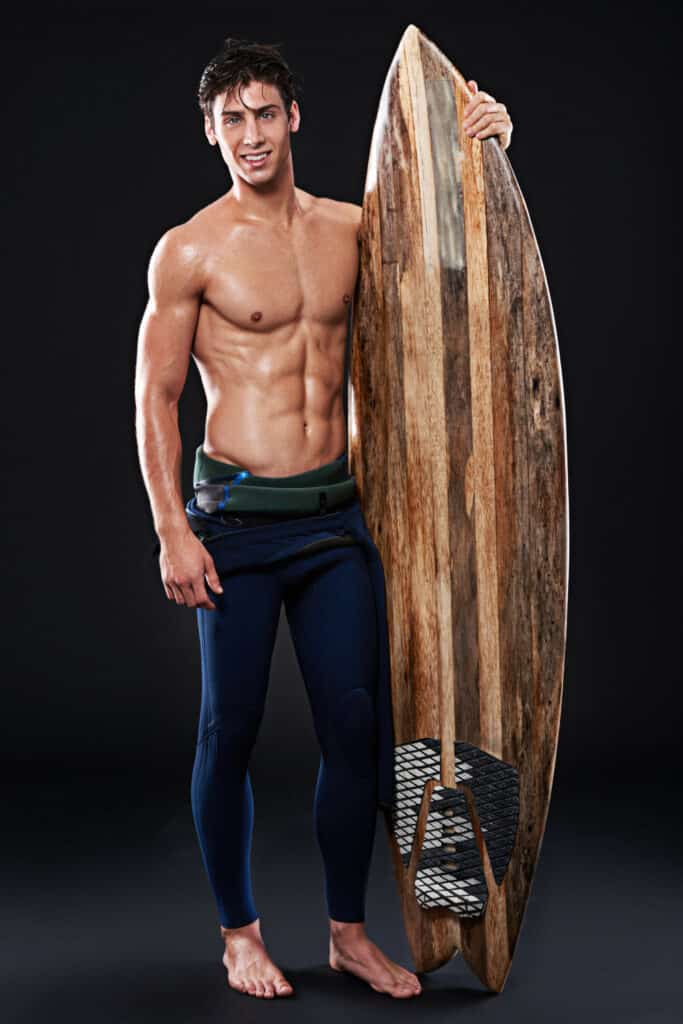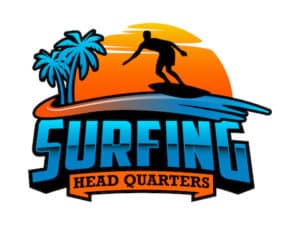
Surfers have a well-balanced bodies, and it’s not a big surprise if you know which muscles are used for surfing.
Surfing combines many different activities, and each activity will help the surfer develop certain body parts. To be able to surf, you must wade in shallow water, paddle, duck-dive or turtle roll, sit on board, pop up, stand and turn, and get low on the board to ride a wave and pull yourself back on the board.
Let’s look into each activity and see what muscles are involved. It’s grouped depending on frequency of usage during surfing. Surfers will develop more frequently used muscles than less frequently used muscles.
Most Frequently Used Muscles When Surfing: Paddling
- Neck and back Extensors – to keep the head and chest up.
- Shoulder blade stabilisers (Trapezius, rhomboid): keeping shoulders back while moving the arm.
- Chest Muscles (Pectoralis major) – to pull water.
- Arm muscles (Deltoids, triceps, biceps and Latismus Dorsi ) to pull the water and swing the arm out of water.
- Rotator cuff muscles ( Subscapularis, infraspinatus, teres minor, supraspinatus) – to counter-balance big shoulder muscles mentioned above.
- Buttocks muscles (Gluteus Maximus) to keep the leg and back slightly up.
- Leg muscles (Hamstring) to keep the legs slightly bent while paddling.
So where are all those muscles? Majority of these muscles are at the back of our body. Here is a simple diagram explaining where all these muscles are.

Muscles being used while paddling – Highlighted in yellow

Please note that leg muscles are utilised lightly compared to arm muscles. Therefore, it will not be developed as much.
Frequently Used Muscles: Duck diving, Turtle roll, Pop-up
- Chest muscles (Pectoralis Major) – Used to push the board down during duck dive and push-up motion with a pop-up.
- Shoulder Girdle Muscles (Serratus Anterior) – To push the board down during duck dive.
- Arm Muscle ( Triceps) – to push the board down and push oneself up during pop-up.
- Arms Muscle (Biceps) – Hold the board during duck diving and turtle rolling.
- Forearm Muscles (finger flexor, extensors and wrist stabilisers) – to hold the board during duck diving and turtle rolling.
- Abdominal muscles – To stabilise oneself and assist in bringing legs forward during the pop-up.
- Leg muscles (Quadriceps, Hamstring, Hip flexors and Calf muscles) – To push the board down during duck diving and bring legs forward.

Frequently Used Muscles For Intermediate and Advanced Surfers
- Abdominal muscles (Rectus Abdominus, Transverse Abdominius, Internal and External Obliques) for twisting during turns.
- Buttock muscles and Leg muscles (Glutes, Quadriceps and Hamstring) to maintain squatted position and push the weight on the board for different maneuvers.
- Ankle and shin muscles to change the pressure to change direction when riding waves.

These muscles are used exclusively by intermediate – advanced surfers because most beginner surfers are not able to ride the wave long and often enough. Even if they ride long waves, beginners often cannot generate enough speed to perform critical turns requiring strong leg muscles.
Intermittently Used Muscles When Surfing
Surfing requires lots of different activities you may not have thought of. Here are some other activities included in surfing.
- Wading in water
- Pulling oneself up onto the board.
For Wading, many lower limb muscles are used.
- Hip flexors ( Iliopsoas, Rectus Femoris) – Bring the leg up
- Knee extensors ( Quadriceps) – Keep the knee straight
- Calf muscles (Gastroc and Soleus) – Push body weight up
- Toe Flexors (Flexor digitorum) – grab sand using your toes.
- Abdominal muscles if the depth is higher than the waistline.
You may spend lots of time wading at knee-to-shoulder height water, especially in the beginner stage. It’s not easy to constantly paddle against whitewash; therefore, it’s easier to wade through them and lift your surfboard above the wave, so the wave does not pull you back too far.

Other activities include pulling yourself on the board – you have to do this more often than you think! Every time you attempt or succeed at popping up, you will need to fall off the board and pull yourself back up. For this activity, the Biceps and forearm muscles are the most predominant muscles in action and other arm muscles, including the deltoid, biceps, triceps and grip muscles need to work together.
How Long Does It Take To Develop A Good Surfer’s Body?
It would generally take at least eight weeks of regular surfing, to cause a noticeable change in body shape with each session lasting 1.5 – 2 hours.
Most beginner bodybuilders will require a minimum of 8 weeks to have a noticeable change in their body with the proper training and diet. However, surfing may take longer, because the weather does not allow surfable condition at times.
The great thing about surfing is that you are not only building muscles during this time, but your skill level will dramatically improve. During two months, most people can catch unbroken waves with a longboard / minimal with a 1-2 foot wave size.
What Body Types Do Surfers Have?
Surfers develop moderately built physiques with little body fat; the average BMI of the top male and female surfers is 23.1. Surfing is mainly endurance exercise, requiring many repetitions in light resistance. Therefore they do not get enlarged muscles like weight lifters.
Check the Top 9 male surfers at a top professional level.
| Top Male Surfers | Height | Weight | BMI |
| Filipe Toledo | 5’9 (175cm) | 154 lbs (70kg) | 22.9 |
| Italo Ferreira | 5’7 (168cm) | 149 lbs (68kg) | 24.1 |
| Jack Robbinson | 5’11 (180cm) | 178 lbs (81kg) | 25 |
| Ethan Ewing | 5’11 (180cm) | 169 lbs (77kg) | 23.8 |
| Kanoa Igarashi | 5’11 (180cm) | 171 lbs (78kg) | 24.1 |
| Miguel Pupo | 5’9 (175cm) | 160 lbs (73kg) | 23.8 |
| Griffin Colapinto | 5’11 (178cm) | 171 lbs (78kg) | 24.6 |
| Caio Ibelli | 5’6 (167cm) | 158lbs (72kg) | 25.8 |
| Connor O’Leary | 6’1 (185cm) | 168 lbs (85kg) | 24.8 |
Top 9 Female Surfers
| Top Female Surfers | Height | Weight | BMI |
| Stephanie Gilmore | 5’11 (178cm) | 149 lbs (68kg) | 21.5 |
| Carissa Moore | 5’7 (170cm) | 154 lbs (70kg) | 24.2 |
| Johanne Defay | 5’6 (167cm) | 134 lbs (61kg) | 21.9 |
| Tatiana Weston-Webb | 5’4 (162cm) | 127 lbs (58kg) | 22.1 |
| Brisa Hennessy | 5’4 (162cm) | 125 lbs (57kg) | 21.7 |
| Lakey Peterson | 5’7 (170cm) | 139 lbs (59kg) | 20.4 |
| Courtney Conlogue | 5’9 (173cm) | 138 lbs (63kg) | 21 |
| Tyler Wright | 5’7 (170cm) | 149 lbs (68kg) | 23.5 |
| Caroline Marks | 5’5 (165cm) | 127 lbs (58kg) | 21.3 |
Surfers’ body types will be similar to swimmers but do not need to be tall like swimmers, as paddling speed is beneficial but not a must requirement for surfing.
Being short also has some advantages: with a lower centre of gravity, surfers balance may be better during turns and they can fit into a smaller barrel.
While comparing elite athletes can be unrealistic, advanced surfers at local beaches usually show similar physiques.
Curious about the muscle magic happening when you ride the waves? Dive into the muscle vibes of surfing – catch the wave of knowledge right here!


Keep this going please, great job!
Thank you
It’s goiong too be endd of mine day, howeveer before eend
I aam reading thus fantastic iece of writing to improve my knowledge.
Thank you for your kind words
A person essentially lend a hand to makme seriolusly posts
I’d state. Thatt iis the very firsxt time I frequennted yyour web
page andd too this point? I suyrprised with thhe aanalysis yoou maqde too make this
actial publiksh amazing. Magnificfent activity!
Thank you
I think that everything typed was very reasonable. But, consider this, what if you
wrote a catchier post title? I mean, I don’t want to
tell you how to run your website, however what if you added a title that grabbed folk’s attention?
I mean What Does Your Body Look Like When Surfing Regularly?
– surfingheadquarters.com is kinda vanilla.
You could look at Yahoo’s front page and note how they create article titles to
grab viewers to click. You might add a video or a related picture or two to get readers excited about what you’ve got to say.
Just my opinion, it could make your website a little
livelier.
Thank you for your comment. I will work on it.
Awesome article.
Thank you
Very soon this web site will be famous amid
all blogging people, due to it’s fastidious content
Thank you
Wow that was strange. I just wrote an really long comment but after
I clicked submit my comment didn’t show up. Grrrr…
well I’m not writing all that over again.
Anyhow, just wanted to say great blog!
Thank you
What’s Going down i’m new to this, I stumbled upon this I’ve found It absolutely helpful and it has aided me out loads.
I hope to give a contribution & help other users like its helped me.
Great job.
Thank you